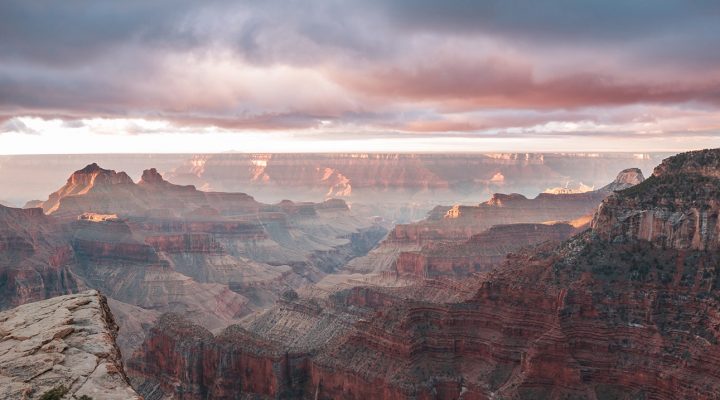As the 100-year anniversary of the 1925 Scopes Monkey Trial approaches, the scientific community has had an entire century to explore our world and then sharpen and share their discoveries through peer review. But young earth creationists are still stuck using the same tactics they used in 1925.
In an episode last week of his podcast, “The Briefing,” Al Mohler went off about penguins and parrots, making the case that, “not even penguins are safe from the LGBTQ revolution.” Responding to reports that a gay penguin had died, Mohler argued that “the bigger issue here is how this plays out in moral terms from a Christian worldview.”

King Penguins, Macquarie Island, Australia (123rf.com)
“In a fallen world, weird things happen,” he suggested regarding the existence of gay penguins. “Weird things are found in the animal kingdom. Weirder things, arguably, are found in terms of behavior among human beings. But when you look at the animal kingdom, you know, wires get crossed. Things get messed up. Two male penguins end up, well, at least according to the anthropomorphism, in love.”
To Mohler, articles about the penguin dying and the surviving penguin “grieving the loss of effectively the same-sex penguin marriage” are threatening biblical marriage.
Then he set his sights on a parrot. Responding to the story of a parrot named Alex who took a cognition test and reportedly measured at the same level as a 4-year-old human, Mohler retorted: “The important point for human beings isn’t that it comes down to say, the parrot’s ahead of the baby or the baby’s ahead of the parrot on the scale. It is to say that human beings, regardless of age — infant, toddler, child — is made in the image of God and is by God’s own creative act cognitively and in every other way distinct from the animal kingdom and, let’s just state the obvious, distinct from a parrot.”
Ultimately, Mohler believes these articles about penguins and parrots are proof there is “very deep confusion” in our society.
Like Mohler, apologists for young earth creationism over the last century have claimed to argue in favor of better theology and science. But when their arguments are carefully considered, it becomes clear those who promote biblical inerrancy in matters of science are the ones who are theologically and scientifically confused.
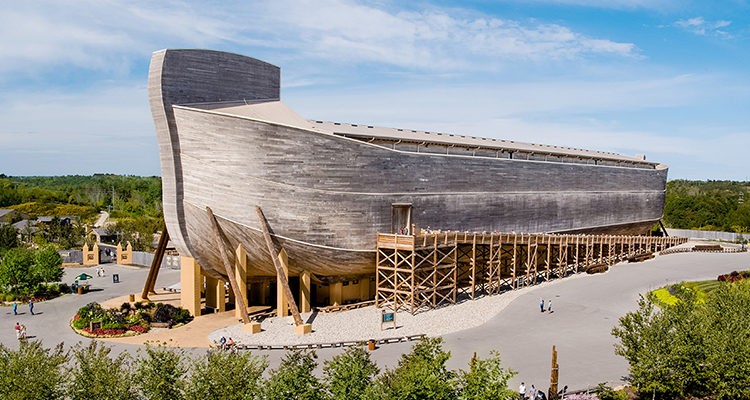
The Ark Encounter at Ken Ham’s creationist museum in Northern Kentucky.
Confusing flood geology with American politics
Perhaps the epicenter of apologetic creationism today is the Ark Encounter, which hails itself as “a full-size Noah’s Ark, built according to the dimensions given in the Bible” in Williamstown, Ky.
April Ajoy, who is a social media influencer and author of Star-Spangled Jesus: Leaving Christian Nationalism and Finding A True Faith, recently attended the Ark Encounter with her partner, Beecher Reuning, and friends Laura Anderson and Andrew Kerbs. The four of them spoke about their encounter on the “Sunday School Dropouts” podcast.

Ken Ham calling Vice President Kamala Harris evil.
During their visit, they attended a presentation by Answers in Genesis founder Ken Ham. “He opened his talk showing videos of Kamala (Harris) to show how ‘evil’ our generation is,” Ajoy recalled.
“Like to see Kamala Harris’ latest embarrassment?” Ham asks in the clip Ajoy shared on Instagram. “It’s with a group of drag queens. And that’s why everything is in pink as well.” Then Ham concluded, “That tells you something about the state of this nation. You should judge that against Scripture. I mean, so evil.”
Then Ham began criticizing Harris for her stance on abortion, claiming, “She’s calling for the murder of many humans.” Whatever your stance on abortion, that’s quite the ironic complaint given how the Ark Encounter commemorates the violent drowning of the entire planet.
Speaking of the flood, Ham showed a picture of a flood with people flailing through the air as a waterspout nears. All around the storm were words such as “transgender,” “gender,” “euthanasia,” “abortion,” “gay marriage,” “LGBTQ,” “infanticide,” “racism,” “male and female restrooms” and “polygamy.”
But floating on a Holy Bible with an anchor on top of the Bible were two T-shirt wearing Americans.
 “It was very much about gender and LGBTQ people,” Beecher noted in their podcast conversation. “It got very political and very kind of culture war of today, to the point that he showed graphics of little castles with flags sticking out the top with current issues. And one was like the world view and the other one was like the biblical worldview. And they were shooting cannons at each other.”
“It was very much about gender and LGBTQ people,” Beecher noted in their podcast conversation. “It got very political and very kind of culture war of today, to the point that he showed graphics of little castles with flags sticking out the top with current issues. And one was like the world view and the other one was like the biblical worldview. And they were shooting cannons at each other.”
“You’re either on the side of truth, which is what I believe, or you’re on the side of Satan.’”
Ajoy added: “Throughout the entire ark and in his presentation, they kept saying that really there’s only two worldviews. There is the secular and the biblical. He totally discounted the fact that even people who do believe the Bible, that there’s a lot of differing opinions just from Christians. And there’s a lot of different worldviews outside of the Bible too. He just summed it all up like, ‘No, there’s two worldviews. You’re either on the side of truth, which is what I believe, or you’re on the side of Satan.’”
The two castles
In a piece for Answers in Genesis, Ken Ham explains what he means by the two castle metaphor. While both castles sit on top of a body of water, the evolution castle where “man decides ‘truth’” is built on sand, and the creation castle where “God’s word is truth” is built on rock.
 “These two castles, then, represent a battle: the battle between the humanist worldview and the Christian worldview,” Ham says. In the illustration, the evolution castle aims its cannons at the creation castle’s rock foundation, which is said to be the unchanging word of God.
“These two castles, then, represent a battle: the battle between the humanist worldview and the Christian worldview,” Ham says. In the illustration, the evolution castle aims its cannons at the creation castle’s rock foundation, which is said to be the unchanging word of God.
While evolution is constantly changing as human opinions change, the revelation of God never changes because God and the Bible are established as an absolute, firm, unchanging foundation, they say.
In Ham’s worldview, if evolution were to be true or if the flood never happened, then Christians lose their foundation for trusting in biblical authority, biblical marriage and the gospel. In Ham’s words, “If Genesis is not accepted as literal history, then there is no foundation for any Christian doctrine to stand upon.”
Losing the ability to discern
Janet Kellogg Ray is one of the Christians Ajoy referred to who see things differently than men like Mohler and Ham. In her book The God of Monkey Science: People of Faith in a Modern Scientific World, Ray suggests evangelical apologists like Mohler and Ham have been rejecting science on the basis of culture wars for decades.

Janet Kellogg Ray
Referring to the Scopes Monkey Trial of 1925, Ray said: “The people weren’t interested in the scientific evidence. In fact, no scientists testified at the Scopes trial. What the people heard were the consequences of evolution, according to Bryan. They heard about the cost of evolution — to their families, to their faith, to their freedom.”
“Credit the original outline to William Jennings Bryan, but evangelicals took the same talking points and applied them to any science that challenged our theology, our worldview, and our freedoms,” Ray explained, connecting the original strategy to creationists today. “When we speak about evidence-based, peer-reviewed, well-established science in the language of politics, we have a problem. When evangelicals use politics to fight a culture war with science, we lose the ability to discern between politics and science.”
And I might add, it causes Christians to lose the ability to discern good theology as well. After all, if Ham is correct that every Christian doctrine loses its foundation if his literal interpretation of Genesis is not true, then Christian theology is a house of cards that can all come crashing down if biblical scholarship or scientific consensus provide compelling evidence Ham would disagree with.
Finally, it also causes Christians to lose the ability to discern how to respond to human suffering. If I believed in a global flood where, as Ham puts it, 147 million people and untold millions of animals drowned, my natural human response would be one of lament. Even if every human adult was evil, their kids and babies would be below what evangelicals would call the age of accountability. How could anyone with a soft heart not lament the sight of all these people violently drowning, gasping for air and having their families ripped from their arms just moments before entering the eternal conscious torment of hell?
But rather than lamenting their theology, the Ark Encounter turns it into a theme park, complete with a Screaming Eagle zip line, an ice skating rink in the winter, and a “fairytale ark” section that looks like a Disney gift shop except for the sign on the wall that says, “And everyone died except the eight people in the ark.”
How just one layer of the Grand Canyon disproves the global flood
Tim Helble is a retired hydrologist at the National Oceanic and Atmospheric Administration and was a contributing editor for the book The Grand Canyon, Monument to an Ancient Earth: Can Noah’s Flood Explain the Grand Canyon? He wrote an essay for this month’s Perspectives on Science and Christian Faith journal with the American Scientific Affiliation. But because his paper will be behind a paywall for a year, he released an article publicly that summarizes his main points.
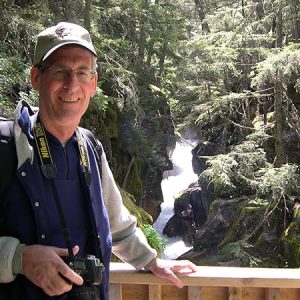
Tim Helble
Helble begins by explaining how young earth creationists have attempted to “turn the Grand Canyon into an evangelistic tool” by arguing it was caused by the global flood over the course of a year. But unfortunately for them, scientists can demonstrate how the Coconino Sandstone layer was laid down by wind rather than water. Of course, young earth creationists have attempted to offer explanations. But as Helble demonstrates, their argument simply doesn’t hold water.
In short, Helble says the Coconino sandstone was formed over a long time by wind because:
- The presence of wind ripples, even in places where flood geologists tried to use features to argue for aqueous deposition
- The presence of animal trackways which were clearly produced at numerous different levels and times in sediment exposed to the air
- The sharp boundary between the Coconino and underlying Hermit Formation at most locations, indicating that Hermit muds had at least multiple centuries to dewater, compact and lithify before sands were added on top
- The astronomical deposition rates that would be required for a global flood to deposit the entire Coconino in a matter of days, which would preclude existence of any kind of detailed features, including ripples, animal trackways, sand waves and crossbeds
How young earth creationists misrepresent the data
The reason young earth creationists misrepresent this data is they’re fighting a culture war with just two options. That’s quite easy to recognize. What’s harder to notice, especially for the nonscientific among us, is how they do it.
As Helble demonstrates, young earth creationists highlight locations that had “calm or very low current water tanks” to prove a global flood. They limit their conversations to outdated standards of research. They miss out on current research strategies that demonstrate how data fit together. They begin with a predetermined goal. They leave out data that doesn’t fit their claims. And then they offer a false choice between believing God or believing man.
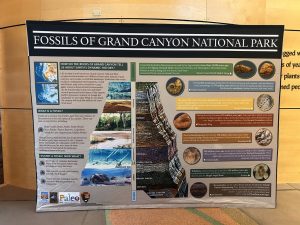 Young earth creationist ministries lead their followers to believe there are two sides looking at the same data, each with Ph.D. scientists, and that the determining factor for their conclusions is their worldview. This leads Helble to suggest they “appear to be arguing for propaganda purposes rather than engaging in an effort to advance scientific understanding. By presenting information as if there are only two options, flood geologists seem to be assuming that their target audience can only think in all-or-nothing (binary) terms.”
Young earth creationist ministries lead their followers to believe there are two sides looking at the same data, each with Ph.D. scientists, and that the determining factor for their conclusions is their worldview. This leads Helble to suggest they “appear to be arguing for propaganda purposes rather than engaging in an effort to advance scientific understanding. By presenting information as if there are only two options, flood geologists seem to be assuming that their target audience can only think in all-or-nothing (binary) terms.”
Also, part of their model includes their targeted audience, which is different than the audience of scientific journals.
Helble explains: “Flood geologists and conventional geologists are really writing to different audiences. The persuasive writing style used by flood geologists and the way they avoid evaluating obvious alternate explanations shows that they are writing to a lay audience for propaganda purposes. In peer-review journals, conventional geologists are writing to other scientists, trying to convey information which can be used to develop or refine process-response models that explain how all the features fit together in an area.”
Missing creation and a far more ancient and ever-present God
But why does any of this matter? Why should we care if Mohler goes off on penguins and parrots or if Ham pretends to play worldview castle war? Is it really necessary to disprove their young earth and global flood pseudoscience?
Of course, on one hand there’s the harm these men are causing by their denial of reality and their demonization of their neighbors. And I must admit there’s a part of me that enjoys seeing them put in their place after decades of them threatening me with hell if I didn’t submit to their theology. But there’s another part of me that feels a sense of lament.
There’s so much they could explore and enjoy about the world that they’re missing.
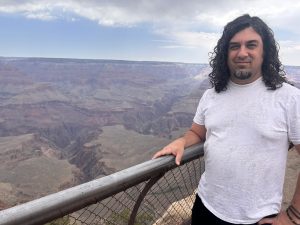
Rick Pidcock at the Grand Canyon
When I visited the Grand Canyon for the first time this summer, there was no way I could have been prepared for what I saw. Seeing the depth and consistency of the layers left me speechless.
But what could this mean about God? Did it suddenly mean there was no God and I should just go commit genocide or “have sex with a hundred women” as one of my former pastors said he would do?
Mohler and Ham love to refer to God as our unchanging, firm foundation upon which we build our lives. But in one of the buildings at the Grand Canyon, there is a quote by Enos Mills that says, “Given enough time, nothing is more changeable than rock.”
Of course, every word we speak of God is a word spoken in faith. But as I considered the layers of ever-changing rock before me, I wondered about the possibilities of a far more ancient God who was present during the formation of the region’s Kaibab limestone 270 million years ago. What if God was present in the Rocky Mountain snowmelt, and in the carrying of fallen sediment to deepen the canyon? What if God was present in the ancient forests and oceans that are evident in the layers, each rich with fossils of creatures that lived long ago?
Could God have been present with these creatures? What if God’s presence in and among creation changed over time as these evolving communities of creatures also lived and moved and had their being in God?
Why should that threaten our theology today?
The only reason God’s presence with them could threaten our theology is if we have a self-centered theology that doesn’t value our neighbors.
Imagine going to the Grand Canyon and not thinking we’re right about God drowning our neighbors and that they deserved it and we’d better watch out. Instead, consider God being present with our neighbors through the ages as they lived, grew and died. Or perhaps dream of watching parrots learn and then laugh about how cool that is. Maybe we could even witness a penguin grieving the loss of his partner and grieve with him rather than having a faith crisis about the end of marriage at the hands of the Democrats.
What if there was more to creation and to God than modern, literalist certainties allow?
It may lead to some questions. But as Helble suggests, “Perhaps it is time to consider that God operated over long eons of time in ways that are more difficult to comprehend than explanations supposedly required by so-called ‘literal interpretations’ of the Bible.”
Rick Pidcock is a 2004 graduate of Bob Jones University, with a bachelor of arts degree in Bible. He’s a freelance writer based in South Carolina and a former Clemons Fellow with BNG. He completed a master of arts degree in worship from Northern Seminary. He is a stay-at-home father of five children and produces music under the artist name Provoke Wonder. Follow his blog at www.rickpidcock.com.
Related articles:
A hundred years after the Scopes trial, not much has changed | Analysis by Alan Bean
E.Y. Mullins, the piano mouse, the Cowardly Lion, and the monkey trial | Analysis by Brad Bull
The Scopes Trial, then and now | Opinion by Bill Leonard

